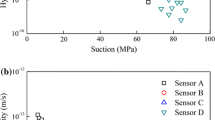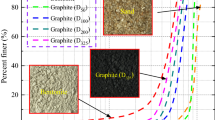Abstract
The characterization of thermal conductivity of the buffer/backfill material is of great importance for dissipating the decay heat of the spent nuclear fuel and safety estimates of disposal site. The buffer/backfill material is usually a kind of complex material, which includes multi composition particles and multi-phase systems in which nearly all the constituents are distributed randomly. Its properties are complicated and that is dependent on all the constituents of material. Therefore, this study’s purpose is to assess the effective thermal conductivity of the Zhihsin clay from Taiwan. First, the matrix material property of Zhihsin clay was obtained by heat transfer, statistics and probability methodology in considering constituents and distribution types. Relative to other bentonites, the effective properties of Zhihsin clay have a higher uncertainty due to the fewer smectite and more complicated compositions. Then, this study takes the matrix material result to estimate the effective values. The ETC of solid of the Zhihsin clay was obtained as normal distribution form N(2.33, 0.07). The results show that the effective values have nonlinear changes under various porosities and saturations. Finally, the equation of the effective thermal conductivity was received by the design of experiment and response surface methodology. In the regression analysis, porosity multiply saturation is one of significant model terms. It represents that the effective thermal conductivity was affected by interaction between porosity and saturation.






Similar content being viewed by others
References
AEC (2004) Study on design of local buffer material for final disposal site of radioactive waste. AEC report, Atomic Energy Council, Taiwan, ROC
Campbell GS (1985) Soil physics with basic transport models for soil-plant systems. Elsevier, New York
Chen YF, Zhou S, Hu R, Zhou CB (2014) Estimating effective thermal conductivity of unsaturated bentonites with consideration of coupled thermo-hydro-mechanical effects. Int J Heat Mass Transf 72:656–667
Cosenza P, Guerin R, Tabbagh A (2003) Relationship between thermal conductivity and water content of soils using numerical modelling. Eur J Soil Sci 54:581–587
Delage P, Cui YJ, Tang AM (2010) Clays in radioactive waste disposal. J Rock Mech Geotech Eng 2:111–123
Gong L, Wang YH, Cheng XD, Zhang RF, Zhang HP (2014) A novel effective medium theory for modelling the thermal conductivity of porous materials. Int J Heat Mass Transf 68(2014):295–298
Gong F, Liu J, Yang J, Qin J, Yang Y, Feng T, Liu W, Duong HM, Papavassiliou DV, Wu M (2017) Effective thermal transport properties in multiphase biological systems containing carbon nanomaterials. RSC Adv 7:13615–13622
Hashin Z, Strikman S (1962) A variational approach to the theory of effective magnetic permeability of multiphase materials. J Appl Phys 33:3125–3131
Huang WH, Chen WC (2004) Swelling behavior of a potential buffer material under simulated near field environment. J Nucl Sci Technol 41:1271–1279
JNC (2000) Safety assessment of the geological disposal system. Supporting report 3. Project to establish technical basis for HLW disposal in Japan. JNC report, JNC TN1410 2000-004
Johansen O (1975) Thermal conductivity of soils. Ph.D. thesis, Trondheim, Norway, 1975 (CRREL Draft Translation 637, 1977) ADA 044002
Jones SB, Or D (2003) Modeled effects on permittivity measurements of water content in high surface area porous media. Phys B 338:284–290
Lee JW, Park SJ, Kim YH, Murakami R (2018) Thermal characteristics of carbon fiber reinforced epoxy containing multi-walled carbon nanotubes. Results Phys 9:1–5
Li YS, LeBoeuf EJ, Basu PK, Mahadevan S (2005) Stochastic modeling of the permeability of randomly generated porous media. Adv Water Resour 28:835–844
Li A, Zhang C, Zhang YF (2017) Thermal conductivity of graphene-polymer composites: mechanisms, properties, and applications. Polymers 9:437
Liu B, Wang H, Qin QH (2018) Modelling and characterization of effective thermal conductivity of single hollow glass microsphere and its powder. Materials 11:133
Lloret A, Villar MV (2007) Advances on the knowledge of the thermo-hydro-mechanical behaviour of heavily compacted ‘‘FEBEX’’ bentonite. Phys Chem Earth 32:701–715
Madsen FT (1998) Clay mineralogical investigations related to nuclear waste disposal. Clay Miner 33:109–129
Maugis P, Imbert C (2007) Confined wetting of FoCa clay powder/pellet mixtures: experimentation and numerical modeling. Phys Chem Earth 32:795–808
Molina-Jordá JM (2018) Thermal conductivity of metal matrix composites with coated inclusions: a new modelling approach for interface engineering design in thermal management. J Alloy Compd 745:849–855
NSC (2007) Study on thermal conductivity of earth materials. NSC report. Ministry of Science and Technology, Taiwan, ROC
Qu XH, Zhang L, Wu M, Ren SB (2011) Review of metal matrix composites with high thermal conductivity for thermal management applications. Prog Natl Sci Mater Int 21:189–197
Rayleigh L (1892) On the influence of obstacles arranged in rectangular order upon the properties of medium. Phil Mag 34:481–502
Singh R (2010) Predictions of effective thermal conductivity of complex materials. In: Öchsner A, Murch G (eds) Heat transfer in multi-phase materials. Advanced structured materials 2. Springer, Berlin
Singh R, Sharma P (2008) Effective thermal conductivity of polymer composites. Adv Eng Mater 10:366–370
Tang AM, Cui YJ, Le TT (2008) A study on the thermal conductivity of compacted bentonites. Appl Clay Sci 41:181–189
Tien YM, Chu CA, Wu PL, Chuang WS, Chung YJ (2010) Improved measurement and a predictive model for thermal conductivity of sand-bentonite mixtures. J GeoEng 5:51–60
Tokoroa T, Ishikawab T, Shiraic S, Nakamura T (2016) Estimation methods for thermal conductivity of sandy soil with electrical characteristics. Soils Found 56:927–936
Torquato S (2002) Statistical description of microstructures. Annu Rev Mater Res 32:77–111
TPC (2009) Preliminary technical feasibility study report for final disposal of spent nuclear fuel. SNFD report, Taiwan Power Company, Taiwan, ROC
Verdier M, Anufriev R, Ramiere A, Termentzidis K, Lacroix D (2017) Thermal conductivity of phononic membranes with aligned and staggered lattices of holes at room and low temperatures. Phys Rev B 95:205438
Villar MV (2000) Caracterización termo-hidro-mecánica de una bentonita de Cabo de Gata. Ph.D. thesis. Universidad Complutense de Madrid, Madrid, Spain
Wang YW (2008) Thermo/hydro coupling effects on temperature distribution and hydraulic conductivity of buffer material. Master thesis, National Central University, Taoyuan, Taiwan, ROC
Weiner O (1904) Lamellare Doppelbrechung. Physikalische Zeitschrift 5:332–339
Ye WM, Chen YG, Chen B, Wang Q, Wang J (2010) Advances on the knowledge of the buffer/backfill properties of heavily-compacted GMZ bentonite. Eng Geol 116:12–20
Yoon S, Kim MJ, Lee SR, Kim GY (2018) Thermal conductivity estimation of compacted bentonite buffer materials for a high-level radioactive waste repository. Nucl Technol 204:213–226
Young IM, Crawford JW, Rappoldt C (2001) New methods and models for characterising structural heterogeneous of soil. Soil Tillage Res 61:33–45
Zhang HF, Ge XS, Ye H (2006) Randomly mixed model for predicting the effective thermal conductivity of moist porous media. J Phys D Appl Phys 39:220–226
Acknowledgements
The authors would like to express gratitude for the financial supports from Atomic Energy Council and Taiwan Power Company.
Author information
Authors and Affiliations
Corresponding author
Additional information
Editorial responsibility: Senthil Kumar Ponnusamy.
Rights and permissions
About this article
Cite this article
Chang, C.H., Chou, H.W. Study on effective thermal conductivity of the local buffer material in Taiwan. Int. J. Environ. Sci. Technol. 16, 6839–6846 (2019). https://doi.org/10.1007/s13762-019-02294-7
Received:
Revised:
Accepted:
Published:
Issue Date:
DOI: https://doi.org/10.1007/s13762-019-02294-7




